Buffalo Calling Stones, Stinging, and Medicine Bundles: Fossil Legends of the Native Americans of the Plains

Between 65 and 90 million years ago, ammonites, a shelled ancestor of the modern squid, thrived along what is now called the Bear Paw Shale. These creatures of the Western Interior Seaway swam among the cephalopods, turtles, plesiosaurs, and mosasaurs, dodging the jaws of larger predators and, sometimes, succumbing to them. As the seaway retreated, some of these sea beasts got caught in clay and over millennia became fossils. Today, they are a treasure trove for paleontologists, who study them in Montana and Alberta.
But they were no less important to the Native American tribes who encountered them for hundreds of years.
A particular ammonite variety known as the baculite was especially sacred, for as baculite fossils erode they break into smaller bits that resemble the profiles of bison.
They are known as buffalo calling stones, or in Blackfoot "Iniskim;" eons after the creature had lived, died, and turned to stone, such a fragment would find itself, after a long journey through space and time, nestled among the prairie brush. If someone walked by, they might faintly hear the sound they were said to make, described by ethnographer George Grinnell in his Blackfoot Lodge Tales as a "peculiar faint chirp." Those blessed to hear the noise did well to search for the source, as it was an object of great power.
The first to find an Iniskim was the wife of a hunter. It was during a time of starvation. First the bison disappeared. Then the small game was hunted until the supply was nearly exhausted. One day, the hunter husband was lucky to bag a small jackrabbit, telling his wife to go to the river and gather water in which to cook the rabbit.
While there, she heard the bison calling stone singing a song, according to Grinnell's version of the tale:
The woman was frightened and dared not pass the tree. Pretty soon the singing stopped, and the I-nis´-kim [buffalo rock] spoke to the woman and said: "Take me to your lodge, and when it is dark, call in the people and teach them the song you have just heard. Pray, too, that you may not starve, and that the buffalo may come back. Do this, and when day comes, your hearts will be glad."
According to the story, the woman returned to her people and did as the stone told her. Almost immediately they heard a gathering rumble—the buffalo returning en masse. Word spread quickly among bands of Blackfeet. From then on, buffalo calling stones would be sacred objects, highly sought after, and rubbed in red ochre to emphasize their power. In Invisible Reality: Storytellers, Storytakers, and the Supernatural World of the Blackfeet, Indigenous writer Rosalyn R. Lapier mentions several similar objects, such as "'worm rocks,' which controlled insects that might be harming their edible plants, ...'oyster rocks' to cross over rivers, [and] 'copper rocks' that made humans stronger and resilient." Such vital and useful objects were stored in medicine bundles.

Medicine bundles were common to Plains Indians, and were small sacks, sometimes of animal skin, that contained priceless items of power. A medicine bundle belonging to a Piegan Blackfoot man from Alberta named Charlie Crow Eagle was purchased and opened by a paleontologist in 1960. According to scientist and writer Adrienne Mayor, Crow Eagle's medicine bundle contained no less than "nine Iniskim: two Baculites compressus, four Placenticeras ammonites, an Acanathoscaphites ammonite, a Paleozoric coral, and a Corbicula clamshell, all coated in red pigment."
A medicine bundle owned by White Man Runs Him, a Crow scout for Custer at Little Bighorn, contained a marine fossil and was decorated with fringe and beads that testified to its effectiveness. The Crow, too, believed that fossils held baaxpee, or mystical powers, including the ability to multiply themselves, and to change in size and shape seasonally.
Mayor writes how a Crow, speaking in 1907, told an anthropologist "[t]hey were light in weight early in spring, but grew heavier by summer... in the coldest winter there would be frost on them, for they breathed."
Most Plains Indians, including the Crow, the Blackfeet, and the Sioux, agreed on a basic cosmology in which the most destructive forces of the Great Plains were personified as opposing monstrous deities; as Mayor writes, "[s]ky and water/earth spirits, whose conflicts symbolized nature's struggle for harmony in Amerindian myths, were personified by Thunder Birds with their lightning and Water Monsters who caused floods."
The war between the Thunder Birds and the Water Monsters involved ranged warfare; they fired missiles at one another which the Sioux called kangi tame, or the blackened remains of lightning bolts. In paleontological terms, they were most often belemnite fossils found after a fierce storm had washed away sediment and unearthed the ancient stones, the "spent ballistics," as Mayor calls them, of these godlike avatars of nature.

As the Thunder Birds and the Water Monsters threw strange stones at each other, so too did Lakota witches, or spider men. They were taught to do so by the evil Gnaski or Crazy Buffalo, who magically "shot" a piece of the bone of a long-dead Water Monster into a Lakota man who returned to his village maddened, behaving like a deranged bull. Wata, the legendary first Medicine Man of the Lakota, removed the bone and warned the tribe against using Gnaski's wakan sica, or bad magic. Ritually "shooting" someone with a fossil shard became known as "stinging."
Even so, there were those who were drawn to the darkness and power of the bad magic and applied themselves to be ḣmuŋġa wicáša, or stinging men. While some erected stone markers around areas with strong fossil magic in an attempt to avoid them, the stinging men would travel there to fast, experience visions, and collect ammunition with which to sting their enemies. In such places, such as Carnegie Hill, Nebraska, Mayor writes, there was "archaeological evidence of vision quest sites, the quests undertaken" by would-be stinging men.
The Crow medicine woman Pretty Shield told ethnographer and Montana writer Frank Linderman another tale of fossil magic. Pretty Shield and a friend found a huge bone preserved in the ground when they were girls. It was clearly not a buffalo, and had a "seam [that] ran from front to back, straight, with no divisions." Pretty Shield's friend dug the skull up, but soon the girls were frightened. They ran and told her father, Crazy Sister-In-Law, a medicine man. Her father gathered a piece of calico, a buffalo robe, and a pipe. He lit the pipe and smoked with the skull, holding it out for the skull to partake. Then, quietly, he spoke to the being, telling it his daughter had not meant to bother it. After he had finished, Crazy Sister-In-Law wrapped the skull in the calico and buried it in the buffalo robe. Pretty Shield's unnamed friend, for having dug up a skull with such strong medicine attached, had bad luck visited upon her later in life.
An Ojibwe account from Canada tells another story. For them, the ground remains of giant fossilized animals were powerful when used in healing potions.
Other fossils served as trade items. Sourced from the Pacific Northwest coast, fresh Dentalia shells were traded on inland networks. Farther inland yet, Native Americans in eastern Montana and the Dakotas found it difficult to obtain fresh Dentalia shells but procured ancient, fossilized versions much closer to home to wear as jewelry.
Perhaps not surprisingly, Native Americans were frequently employed by the first generation of American fossil hunters as guides and scouts. Red Cloud's son Sword served in this capacity, as did a Lakota named Silas Fills Pipe, a friend of Black Elk. Frederick Scott Berryman hired a Crow guide named White Bear, who led him to a petrified forest. Unfortunately, many Native guides go unnamed in the historical record, forgotten.

The Indigenous people of the high plains and the mountain West showed remarkably astute readings of some fossils, including the recognition that the creatures they were seeing preserved in stone were the remains of an ancient ocean. An Assiniboine man named Bull's Dry Bones put it succinctly: "The whole surface of the earth was at a time covered with water." Native Americans also often called some mastodon and dinosaur skeletons "grandfather of the buffalo."
Unlike the Greeks and Romans, who likewise discovered and attempted to grapple with the paleontological evidence left behind by dinosaurs and prehistoric megafauna and [1] decided they were the bones of mythological animals such as cyclops and centaurs, the Indigenous people of North America largely concluded that the strange bones they found belonged to ancient beasts that, while spiritual in nature, were ancestors of the animals they saw every day.
One demonstration of the sophistication of the Indigenous people of the plains is that the Crow, who lived thousands of miles away from the American Southeast, had a word for "alligator." Whether the Crow knew about the alligator through indirect contact with peoples who had encountered one, or whether they had seen a fossilized alligator, it is remarkable to note that they had accurately preserved their knowledge of the creature they could never have seen alive, and given it a name.
Adrienne Mayor has pointed out how the beliefs of the Indigenous people of the American high plains and mountain West anticipated some of the tenets of modern paleontology: that these bones were very old, that they represent a species that has since vanished, and that they may well be the antecedents, or "grandfathers" of the creatures we share the land with today.
Native American fossil legends of the high plains are one of those places where science and cultural narratives intersect. Thunder Beasts and Water Beasts were both spiritual beings important to Native cosmology and were, after all, real.
There were great winged monsters that wheeled around the clouds among arcing gouts of lightning. Huge creatures did once swim in Montana's seas, hunting prey and eluding predators in shoals that are now badlands. Bison did have grandfathers; the great Bison latifrons stood eight feet high and over fifteen feet long as it ruminated on prairie grass some 20,000 years ago. And millions of years even before that, distinctly bison-like ceratopsid dinosaurs roamed the same lands as would their metaphorical great-grandchildren, and the first people who would rely on them for food.
Like the contents of a medicine bundle, the Native Americans of Montana safeguarded their knowledge, curiosity, and stories, passing them down and preserving them from generation to generation. The scientific process more or less aims to do the same.
It makes you wonder what marvels remain to be discovered, or rediscovered, on the frontier where human culture and scientific inquiry meet?

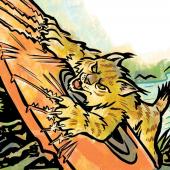

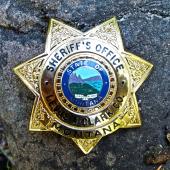

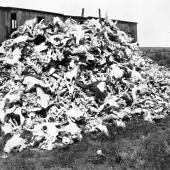
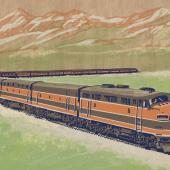
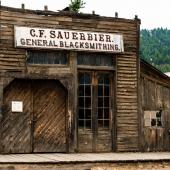





Leave a Comment Here